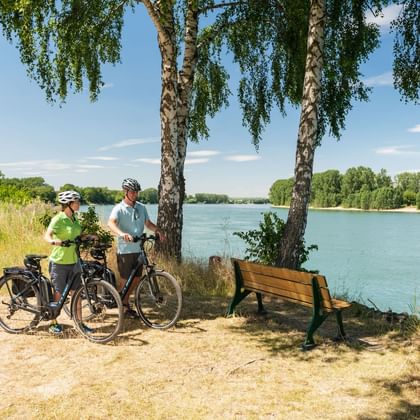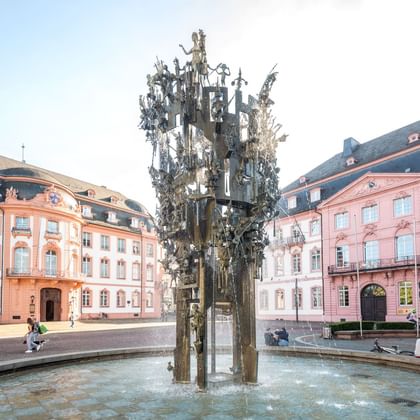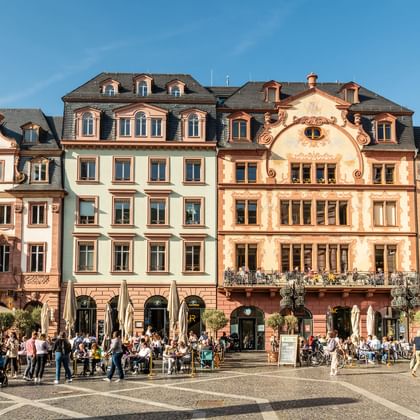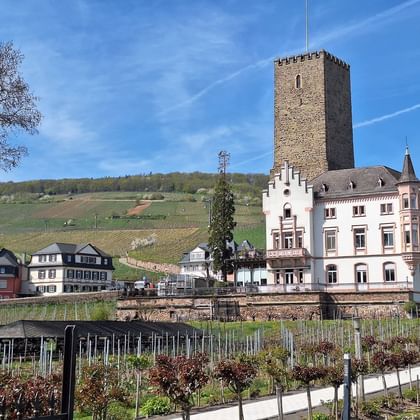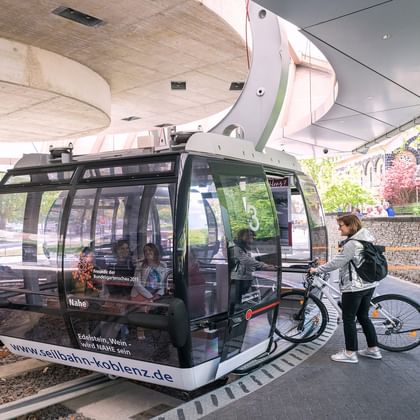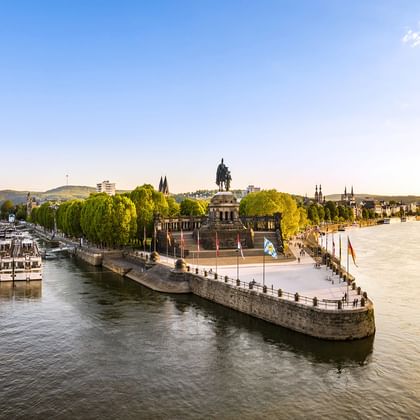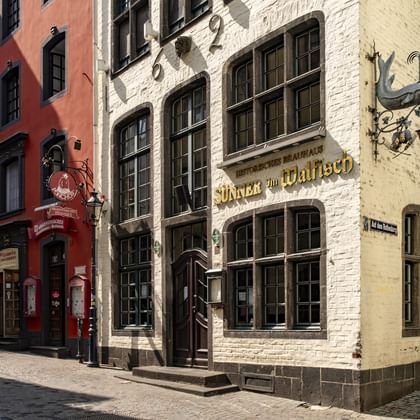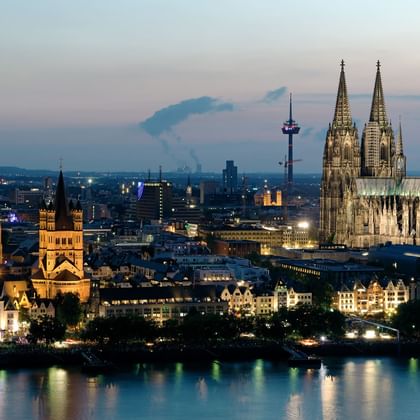Tour
Arrive at Mainz in time! Not only the Roman-Germanic Central Museum, the Gutenberg Museum, the Imperial Cathedral and the Electoral Palace are worth an extended visit.
Welcome to the UNESCO Upper Middle Rhine Valley! The beautiful first stage leads through rolling vineyards and well-known wine villages. The Rhine is flowing quite unhurriedly, forming little islands and broadening its bed up to 800 m width! We recommend to include worthwhile trips to the half-timbered town of Eltville and monastery Eberbach (+ 14 km). In Rudesheim you should use the opportunity for a wine tasting, a stroll through the famous Drosselgasse or a relaxing ride on the cable car up to the Niederwald Monument.
From Rudesheim to Bingen you can take the Rhine ferry and then cycle on the well-developed bike path to Bacharach. Alone on these 16 km you will pass the Mäuseturm, the castles Rheinstein and Reichenstein and Burg Sooneck and Hohneck and the ruin Fürstenberg. Everywhere it is worth to take a break and in Bacharach, you should climb the city walls before you finally cycle to Oberwesel or St. Goar.
In the morning you can visit the Loreley. A hiking trail leads up and gives you the beautiful view to the narrowest part in the romantic Rhine valley. The worth visiting visitor center on the Loreley offers interesting insights into the history, nature and culture of the region as well as the myth of the Loreley. The path goes further in the narrow Rhine Valley, today the route leads first up in the well known wine village Boppard. Here it will turbulent, but you can escape by chairlift to Vierseenblick in densely wooded heights and again enjoy a beautiful view of the Rhine Valley. Or visit the well preserved Marksburg and Castle Stolzenfels further on the way to the Deutsches Eck in Koblenz, where you will end your day.
Also today, the Castles on the Rhine will be your loyal companion. In Sayn and Neuwied, Andernach or Namedy and also in Brohl and Bad Breisig, the palaces and castles invite you to a visit. On the flat Rhine cycle path you can drift comfortably and find even more time to relax at the end of the day at the spa "Römerthermen" in Bad Breisig.
This morning Remagen is worth a stop. See the location where the former towers of the famous bridge rise on the banks and where today an attractions peace museum is located. In Bad Honnef the pedestrian zone and the marketplace with many cafes invite to pause. Ot you visit the island Grafenwerth which is lying with lush meadows and ancient trees in the middle of the Rhine and is considered a recreational paradise. In the cause of the tour the Siebengebirge comes close to the river and in Koenigswinter you can go up with the oldest rack railway to the "fabled" Drachenfels and enjoy the view. Finally Bonn attracts with numerous monuments and museums, and you can again experience an interesting day.
Today the flat Rhine Cycle Route leads always right on the shore. This ensures that the stage to Cologne will be a real pleasure. Even from afar the Cologne Cathedral is moving into focus and increases the anticipation for this destination. Today the stage is not too long, and you can reach your hotel in downtown early. This gives you enough time to admire the manifold sights of Cologne.
Today your beautiful cycling holiday ends after breakfast in Cologne at the hotel. Those who want to return to Mainz, we recommend our practical return transfer service which will take you direct from the hotel in Cologne back to the start hotel.
MAP
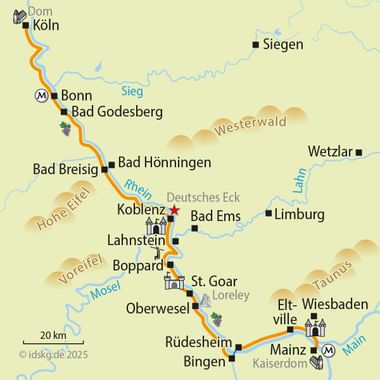
Prices / Dates
Services / Info
- Accommodation incl. breakfast: Comfortable middle-class hotels, mostly in the center
- Room with shower/bath/WC
- Luggage transport
- Digital route guidance via smartphone app
- Tips for tour preparation
- Touristic information
- 7 days hotline service
Worth knowing about the bike tour Rhine: laid-back tour, Mainz - Cologne
Below you will find specific and helpful information. If you have further questions about this trip, you simply call us: Phone: +49 (0)6421 – 886890.
Arrival by train
Mainz is easily accessible from all major cities in Germany by train. We recommend to take a taxi from the trainstation to get to you hotel. Current schedule information and price information can be found at www.bahn.de.
Parking facilities at the arrival location
The hotels in Mainz have no parking facilities. You can park in one of the municipal parking garages near the hotel. You will find further information in your travel information 2 weeks prior to your arrival.
Condition of cycle paths
The route along the Rhine runs almost exclusively on asphalted and paved hiking and cycling trails or along quiet country roads. Driving in traffic is rare. From Mainz to Bad Godesberg, the route is marked with white and green signs, which always identify the next town. Also you will see blue signs with a yellow bike. On the last day cycling to Cologne will see the signs of the Rheinschiene route (square plates with blue wave symbol). Due to the consistently good signage the right way is easy to find.
Transfer back to the starting point of the journey
Thursdays and Saturdays at 11 am there is the possibility to transfer back to Mainz with a small bus (with bike trailer). Arrival at 2 pm. The driver picks you up at your hotel and has space for you, your luggage and your own bicycle. The bus takes you back to your first hotel, thus ensuring a perfect return service without the hassle of hauling luggage.
Train and bike along the Rhine
Along the route there are good rail connections, so you can always take the train for some sections.
Boat and bike along the Rhine
Particularly the Middle Rhine Valley a boat tour is a delightful addition to cycling. The major part of the passenger traffic on the Rhine route is done by the Cologne-Düsseldorf shipping company. Bicycles can be taken on all ships.
Extra costs which are not included in the tour price
The ferry crossing from Rüdesheim to Bingen is not included in the tour price and must be paid on site. Likewise, any tourism tax and charging fees for bicycle batteries are not included in the tour price and must therefore be paid at the hotel.
7 day hotline service
Just in case the bike chain breaks, flooding makes it impossible to continue your tour or any other nasty surprise: You can reach us seven days a week and we will do anything to help you as fast as possible.
Passport and visa requirements
For EU citizens, there are no special passport or visa requirements and no health formalities to be considered for this trip.
Travel insurance
The tour price already includes the statutory insolvency insurance. In addition, we recommend that you take out travel cancellation insurance upon receipt of your travel confirmation in order to protect yourself against financial disadvantages in the event of travel cancellation, interruption of travel, illness or accident.
Englisch: For this trip, we recommend using digital travel documents in the interest of sustainability. However, if you prefer, you can choose printed travel documents with a cycling map during the booking process. Please note that price differences may apply depending on your selection.
Available rental bikes
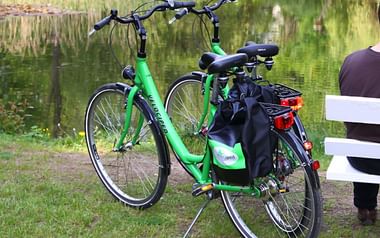
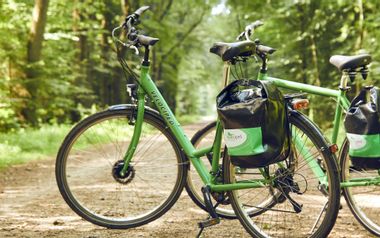
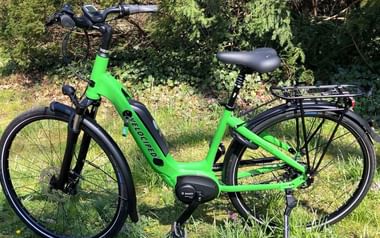


We would recommend the 7-speed tourer for all those that are looking for a back-pedal brake and wide gel seat for maximum comfort in an upright sitting position. It is equipped with a simple hub gear shift and is perfectly suited to tours on flat to slightly hilly terrain.

The 27-speed tourer is the best choice for cyclists that value the advantages of the dérailleur gear shift for flexibility whilst going up and down hills. This bike allows you to be a little more active without compromising on saddle comfort and practical everyday suitability.

E-bikes combine a lot of advantages. The electric drive ensures a completely relaxed cycling, even during long tours or on hilly routes. Other features, such as a suspension seat post and front fork plus well-tuned gears, ensure additional riding comfort.

On this trip, you can choose between e-bikes with a back-pedal brake or a freewheel. The e-bikes with a freewheel also offer you excellent riding comfort with a suspension seat post and front fork. Please simply indicate your preference when booking.
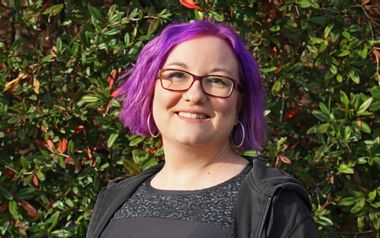
I provide you with advice and assistance
Steffi Groß
